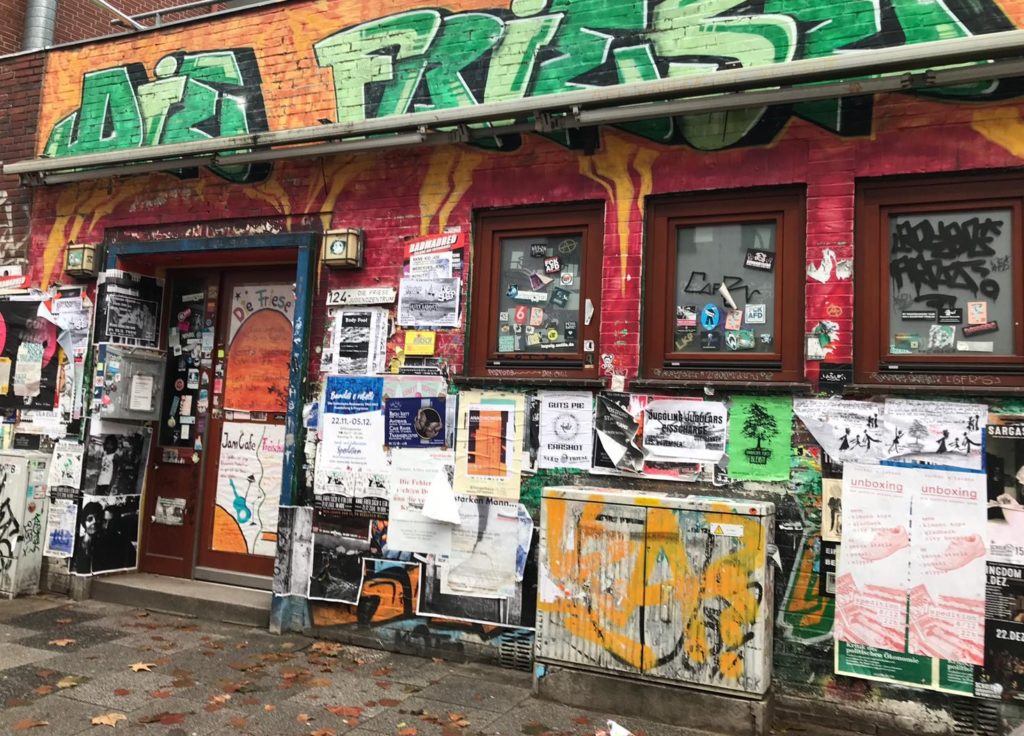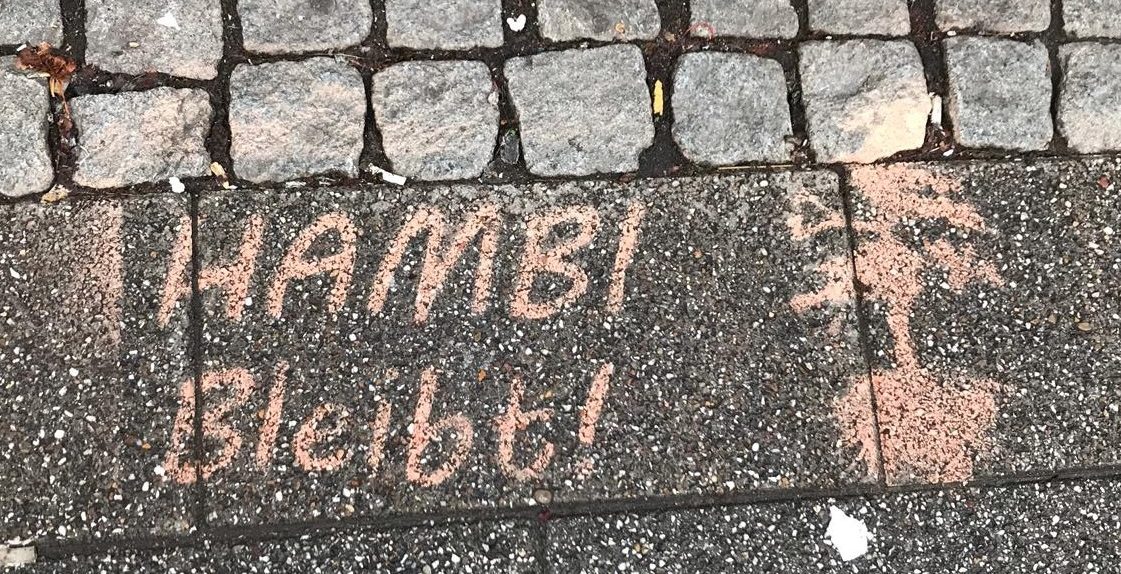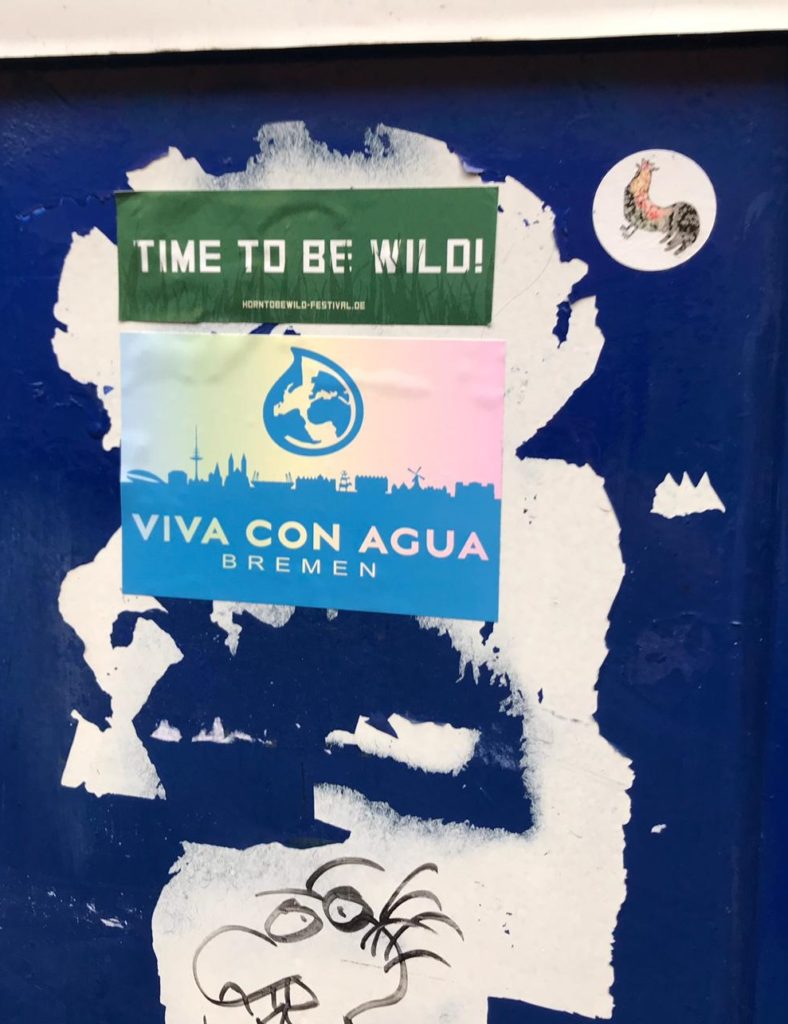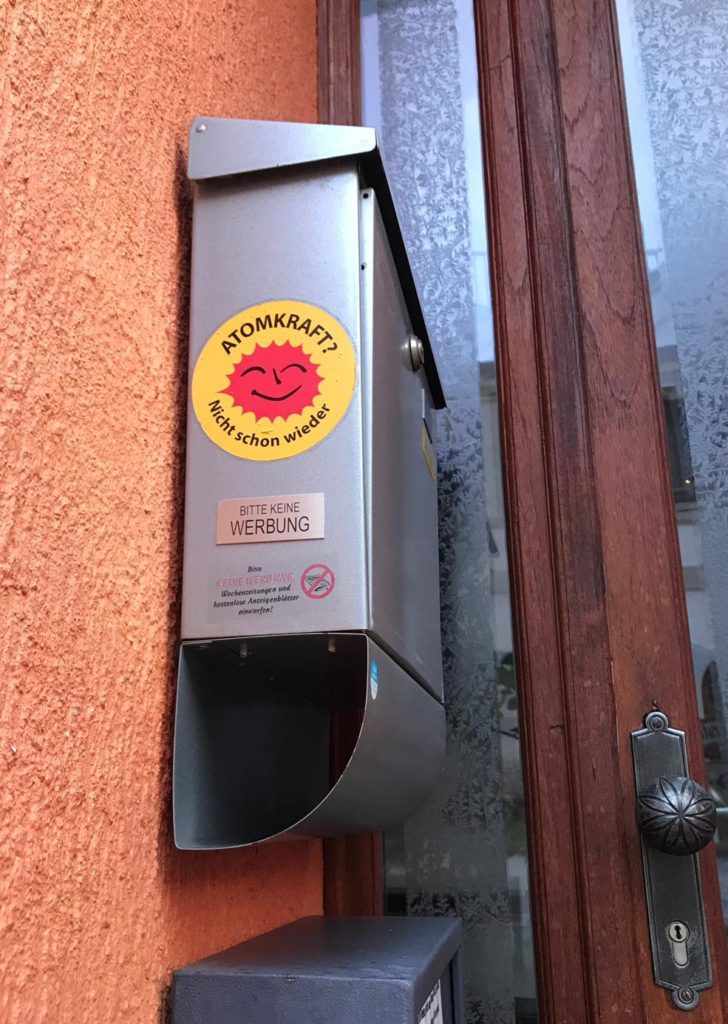In walking through the Bremen Viertel, one will face an onslaught of fliers, graffiti, stickers, and signs promoting almost every leftist socio-political cause under the sun. Footprints of activism pertaining to issues such as sexism, racism, homophobia, animal cruelty, war, fascism, and capitalism cohabitate every corner. Considering the statistic that the average viewing time for a single poster is one and half seconds (Demarmels, pg. 233), it is likely many of the messages become lost amongst one another until they are no more than colorful storefront displays. One of the movements lost in these overwhelming traces of activism is environmentalism.

Like the other movements in the Viertel, the environmental movement takes the physical form graffiti, posters, stickers, signs, and even sidewalk paint. Along with various physical forms, Viertel environmental activism takes the form of many specific causes. Go Vegan, Save the Whales, Buy Secondhand, Live Zero Waste, and Vote for the Greens are just a few examples. It is also important to acknowledge the support shown for causes in what I will identify as first, second, and third levels organizations/movements; the first level pertains to those originating in Germany and remaining regional, the second to those originating in Germany and becoming international, and the third to those originating internationally and gaining popularity in Germany. Examples of these three different levels are provided below.
First Level: Save Hambi

Save Hambi is particularly popular in the North-Western states of Germany, protesting the destruction of the Hambacher Forest (located near Cologne) at the hands of the coal industry. The movement began in 2012 and has been extremely active since. Due to escalation of force against the forest in the fall of 2018, advertisement for the movement as exploded in cities like Bremen. Save Hambi is active in all aspects: it has many people actively participating in protests, some even living in Treehouses in the Hambacher Forest to prevent deforestation. In terms of passive protest, one can find sidewalk graffiti as shown in the image above, wall graffiti, stickers, posters, T-Shirts and banners. There is also a very active citizen’s blog on the Save Hambi website in which educational articles and think pieces are posted about the movement, which can be accessed in four different languages.
I am considering Save Hambi a ‘first level’ movement because it has originated from and been primarily contained in the North-Western states of Germany. Though known in other countries, nearly all passive and active activism has been conducted within Germany. As one can see when they walk through the Viertel, Bremen is one of the cites of this activism.
Second Level: Viva con Agua

Viva con Agua originated out of Saint-Pauli district but has achieved international status, seeking to provide clean drinking water to people in need of it around the globe. The organization was founded in 2005, slowly developing each year to gain more and more support. There are several in Germany and quite a few around the world. As advertised by this sticker, there is an active chapter in Bremen that participants are recruiting for. The more members of the organization, the more clean water can be brought to the thirsty of the world. Viva con Agua does not hold traditional protests, but instead conducts its activism through non-profit work. Viva has its own website in which onlookers can learn about its history, join their local chapters, and donate to specific projects. Its social media presence accompanies the physical activism of displayed stickers that you can find in the Bremen Viertel.
I am considering Viva con Agua a ‘second level’ organization since it originated in Germany, but has spread throughout the country and around the world. Bremen is home to a proud and active chapter which, you can learn more about online or through observing the forms of passive activism local members have posted in the Viertel.
Third Level: Anti-Nuclear Movement

Anti-Nuclearism has been a prominent environmental movement around the world, picking up popularity in Germany specifically in the 1970s. Though it is difficult to give an exact date for its founding, the Anti-Nuclear movement has spread all over the world since the 1960s when the United States, Soviet Union, and United Kingdom signed the Nuclear Test Ban Treaty. Multiple organizations advocate for a nuclear-free world, manifesting into multiple different causes (Britannica). The two most often heard of are those who oppose nuclear weapons and those who oppose nuclear energy. The cause represented by this particular sticker is against nuclear energy in support of environmental health. Known as the ‘Smiling Sun,’ this particular Anti-Nuclear symbol was created in 1975 by a Danish activist seeking to oppose nuclear power in a polite, rather than aggressive, way (Der Spiegel). The Smiling Sun can be found all over the world, the Bremen Viertel included.
I’m considering the Anti-Nuclear movement a third level organization/movement because it did not originate in Germany but found its way into the heart of the country, surviving many decades and taking any form of passive and active protest one could imagine. One does not have to strain their eyes to find a Smiling Sun sticker in the Viertel.
The causes and organizations mentioned above are just a fraction of the environmental movements advocated for through visual forms of protest in the Bremen Viertel. One must go and take a walk for themselves to truly absorb the scope of the passion Bremeners in the Viertel seem to possess for the environment, as well as for the aforementioned causes and movements. As posters are generally viewed in the context of art rather than politics by intellectuals in the humanities (Demarmels, pg. 236), the sheer mass of visual forms of environmental activism that continues to exist in the age of digital media activism should be further studied in order to be better understood. Till then, go and admire the passion of Bremeners for yourself.
Bibliography:
Demarmels, Sascha (2016): Posters and Placards, in: Kathrin Fahlenbrach, Martin Klimke, and Joachim Scharloth (eds.), Protest Cultures. A Companion, New York, NY: Berghahn Books, pp. 233–242
URL: https://www.britannica.com/topic/anti-nuclear-movement
URL: http://www.spiegel.de/international/zeitgeist/the-origin-of-the-anti-nuclear-emblem-we-wanted-a-logo-that-was-cheerful-and-polite-a-773903.html
Images taken by Maria Leon and edited by Elizabeth Bodenman
